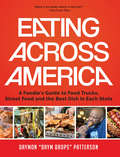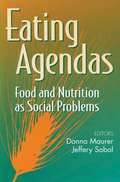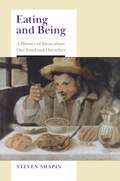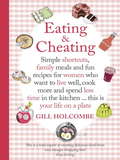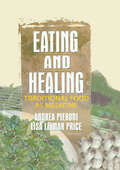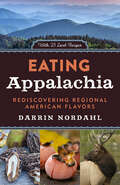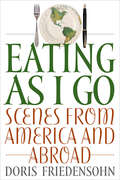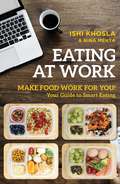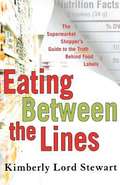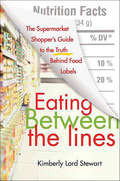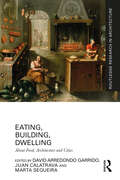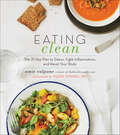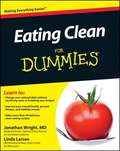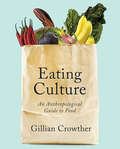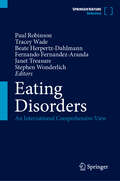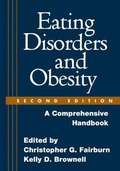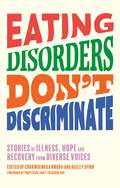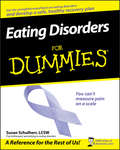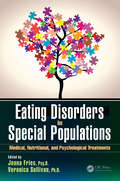- Table View
- List View
Eating Across America: A Foodie's Guide to Food Trucks, Street Food and the Best Dish in Each State
by Daymon PattersonBest Daym TakeoutDrive-ins, diners and dives: Daymon Patterson, author of Eating Across America, is better known as Daym Drops, an American food critic, YouTube celebrity, and television presenter. He initially gained popularity on YouTube for his video review of a Five Guys takeoutmeal, which spawned a viral online song by the Gregory Brothers. He hosted Best Daym Takeout, a food-review oriented television program on the Travel Channel, based on his experiences and with certain aspects borrowed from his YouTube channel. "Best Daym Takeout", aired in 2013, with works featured on The Jimmy Fallon show. That's where Rachel Ray's Team found me, and brought me on for a few episodes before Rachel Ray offered me a position on the show as her Food Correspondent. I travel abroad, sampling dishes and many QSR locations, all to give them a Super Official Food Review from the front seat of my Truck.Cheap eats, food trucks and street food: Shows like Diners, Drive-ins and Dives have never been more popular. And they have inspired a movement. More and more, people are packing up their cars and road tripping in search of cheap eats, food trucks and street food. Daym Drops offers Eating Across America for all traveling foodies.
Eating Agendas: Food and Nutrition as Social Problems
by Donna Maurer Jeffery SobalThe international group of sociological and nutritional scientists in this volume represent the research that has been conducted on the social problematics of food and nutrition in such areas as food safety, biotechnology, food stamp programs, obesity, anorexia nervosa, and vegetarianism. The broad range of topics addressed and the case studies examined make this book suitable as a course-related text both in foodways and cultural aspects of nutrition and as a new departure in social problems courses.
Eating and Being: A History of Ideas about Our Food and Ourselves
by Steven ShapinWhat we eat, who we are, and the relationship between the two. Eating and Being is a history of Western thinking about food, eating, knowledge, and ourselves. In modern thought, eating is about what is good for you, not about what is good. Eating is about health, not about virtue. Yet this has not always been the case. For a great span of the past—from antiquity through about the middle of the eighteenth century—one of the most pervasive branches of medicine was known as dietetics, prescribing not only what people should eat but also how they should order many aspects of their lives, including sleep, exercise, and emotional management. Dietetics did not distinguish between the medical and the moral, nor did it acknowledge the difference between what was good for you and what was good. Dietetics counseled moderation in all things, where moderation was counted as a virtue as well as the way to health. But during the nineteenth century, nutrition science began to replace the language of traditional dietetics with the vocabulary of proteins, fats, carbohydrates, and calories, and the medical and the moral went their separate ways. Steven Shapin shows how much depended upon that shift, and he also explores the extent to which the sensibilities of dietetics have been lost. Throughout this rich history, he evokes what it felt like to eat during another historical period and invites us to reflect on what it means to feel about food as we now do. Shapin shows how the change from dietetics to nutrition science fundamentally altered how we think about our food and its powers, our bodies, and our minds.
Eating and Cheating: Simple Shortcuts, Family Meals And Fun Recipes For Women Who Want To Live Well, Cook More And Spend Less Time In The Kitchen €¦ This Is Your Life On A Plate
by Gill HolcombeFrom the bestselling author of How to Feed Your Whole Family...comes a cookbook for busy women who want it all. Eating and Cheating is full of easy-to-follow recipes to match your every mood, from nutritious family meals and home baking, to child (and adult) friendly party food. Whether you're a working mum, a lady who lunches, a guilty fast-food freak or a self-indulgent comfort eater -- or all of the above -- this book has the recipe, in its most simple, tried-and-tested form. Eating and Cheating is about fun, good value, delicious food, healthy eating (mostly), real life -- and recipes you'll actually want to try out. Praise for How to Feed Your Whole Family ...'Genuinely useful for those on a tight budget' Guardian 'The antidote to celebrity chefs' lavish recipes' Telegraph
Eating and Cheating: Simple shortcuts, family meals and fun recipes for women who want to live well, cook more and spend less time in the kitchen … this is your life on a plate
by Gill HolcombeFrom the bestselling author of How to Feed Your Whole Family...comes a cookbook for busy women who want it all. Eating and Cheating is full of easy-to-follow recipes to match your every mood, from nutritious family meals and home baking, to child (and adult) friendly party food. Whether you're a working mum, a lady who lunches, a guilty fast-food freak or a self-indulgent comfort eater -- or all of the above -- this book has the recipe, in its most simple, tried-and-tested form. Eating and Cheating is about fun, good value, delicious food, healthy eating (mostly), real life -- and recipes you'll actually want to try out. Praise for How to Feed Your Whole Family ...'Genuinely useful for those on a tight budget' Guardian 'The antidote to celebrity chefs' lavish recipes' Telegraph
Eating and Healing: Traditional Food As Medicine
by Andrea Pieroni Lisa PriceDiscover neglected wild food sourcesthat can also be used as medicine!The long-standing notion of food as medicine, medicine as food, can be traced back to Hippocrates. Eating and Healing: Traditional Food As Medicine is a global overview of wild and semi-domesticated foods and their use as medicine in traditional s
Eating Appalachia: Rediscovering Regional American Flavors
by Darrin NordahlDozens of indigenous fruits, vegetables, nuts, and game animals are waiting to be rediscovered by American epicures, and Appalachia stocks the largest pantry with these delectable flavors. Eating Appalachia looks at the uniquely flavorful foods that are native to the region--including pawpaws, American persimmons, ramps, hickory nuts, and elk, among others--with 23 mouthwatering recipes and 45 color photographs. The book also profiles the food festivals including the Pawpaw Festival in Albany, Ohio; the Feast of the Ramson in Richmond, West Virginia; and Elk Night at Jenny Wiley State Park in Prestonburg, Kentucky. There are recipes for every ingredient: Pawpaw Panna Cotta, Chianti Braised Elk Stew, Pan-Fried Squirrel with Squirrel Gravy, Persimmon-Hickory Nut Bread, and Wild Ginger Poached Pears. Nordahl also discusses some of the larger agribusiness, governmental agency, and ecological issues that prevent these wild, and arguably tastier, foods from reaching our table.
Eating as I Go: Scenes from America and Abroad
by Doris Friedensohn&”In an engaging series of memoir essays&” the author traverses countries and friendships, &“examining the relationship between culture and food" (Library Journal). What do we learn from eating? About ourselves? Others? In this unique memoir of a life shaped by the pleasures of the table, Doris Friedensohn uses eating as an occasion for inquiry. Munching on quesadillas and kimchi in her suburban New Jersey neighborhood, she reflects on her exploration of food over fifty years and across four continents. Relishing couscous in Tunisia and khachapuri in the Republic of Georgia, she explores the ways strangers come together and maintain their differences through food. As a young woman, Friedensohn was determined not to be a provincial American. Chinese, French, Mexican, and Mediterranean cuisines beckoned to her like mysterious suitors, and each rendezvous with an unfamiliar food was a celebration of cosmopolitan living. Friedensohn's memories range from Thanksgiving at a Middle Eastern restaurant to the taste of fried grasshoppers in Oaxaca. Her wry dramas of the dining room, restaurant, market, and kitchen ripple with tensions—political, religious, psychological, and spiritual. Eating as I Go is one woman's distinctive mélange of memoir, traveler's tale, and cultural commentary.
Eating at Work: Make Food Work for You!
by Ishi KhoslaRenowned nutritionist Ishi Khosla shows us how to make minimal lifestyle changes for lifelong health benefits! Here’s a unique offering for every kind of professional. For those with irregular or late night shifts, for those on the go, for those with sedentary day jobs – whether you are a doctor, a model, a manager or a school teacher – Ishi Khosla understands your constraints and lifestyle and offers you easy-to-follow tips, interesting food knowledge, small-sized capsules of advice and even recipes.Replete with case studies, food maps, charts (with both scientific and lifestyle information), important diet-related statistics and figures and lively illustrations, this is a must-have for those who want to be fitter, happier and as beautiful on the outside as on the inside!
Eating Between The Lines: The Supermarket Shopper's Guide to the Truth Behind Food Labels
by Kimberly Stewart<p>So many labels, so little time—just tell me what to buy! <p>If you—like millions of other Americans—still don't know how to read food labels and are frustrated by the hundreds of nutrition and health claims as well as statements like free-range and grassfed, it's time to learn what you're really putting into your body...find out how to select the most healthy foods at the supermarket and still get dinner on the table by 6:00 pm with EATING BETWEEN THE LINES <p>Shopping is no longer as simple as deciding what's for dinner. Food labels like "organic," "natural," "low carb," and "fat free!" scream out at you from every aisle at the supermarket. Some claims are certified by authoritative groups such as the FDA and USDA, but much of our country's nutrition information is simply a marketing ploy. If you want to know what food labels really mean—and what they could mean to your health—EATING BETWEEN THE LINES will explain why.</p>
Eating Between the Lines: The Supermarket Shopper's Guide to the Truth Behind Food Labels
by Kimberly Lord StewartSo many labels, so little time—just tell me what to buy!If you—like millions of other Americans—still don't know how to read food labels and are frustrated by the hundreds of nutrition and health claims as well as statements like free-range and grassfed, it's time to learn what you're really putting into your body…find out how to select the most healthy foods at the supermarket and still get dinner on the table by 6:00 pm with EATING BETWEEN THE LINESShopping is no longer as simple as deciding what's for dinner. Food labels like "organic," "natural," "low carb," and "fat free!" scream out at you from every aisle at the supermarket. Some claims are certified by authoritative groups such as the FDA and USDA, but much of our country's nutrition information is simply a marketing ploy. If you want to know what food labels really mean—and what they could mean to your health—EATING BETWEEN THE LINES will explain why:--Chickens labeled "free range" may never actually see daylight --Organic seafood may be a misnomer. --The words "hormone-free" on pork, eggs and poultry is meaningless --"Low fat" cookies and "heart-healthy" cereals may contain heart damaging trans-fatty acids …and more. Organized by supermarket section, from the vegetable aisle to the dairy case, EATING BETWEEN THE LINES also features more than seventy actual food labels and detachable shopping lists for your convenience—and to help bring the best food to the table for you and your family.
Eating, Building, Dwelling: About Food, Architecture and Cities (Routledge Research in Architecture)
by David Arredondo Garrido Juan Calatrava Marta SequeiraThe intricate relationship between food, city and architecture, spanning from ancient civilizations to the present, serves as a focal point for interdisciplinary discourse. This book delves into a diverse set of cases throughout history in which processes related to food significantly influenced architectural or urban designs.This book delineates three spatial levels — city, home and intermediate spaces — illuminating their dynamic interplay within the construct of a continually evolving “food space." Featuring 12 contributions from Mediterranean Europe, this publication explores historical legacies and contemporary challenges. Divided into urban-territorial and architectural scales, it offers nuanced insights into urban dynamics, domestic life and gastronomic tourism. Supported by a prestigious introductory study, this research advances a comprehensive understanding of food's role in shaping urban environments.Through the chapters of this book, those interested in cultural studies of food, urban history and architecture will be able to reflect on our relationship with food and its processes, and how it affects the way we live and design our cities and their architectures.
Eating Chinese
by Lily Cho"Chicken fried rice, sweet and sour pork, and an order of onion rings, please."Chinese restaurants in small town Canada are at once everywhere - you would be hard pressed to find a town without a Chinese restaurant - and yet they are conspicuously absent in critical discussions of Chinese diasporic culture or even in popular writing about Chinese food. In Eating Chinese, Lily Cho examines Chinese restaurants as spaces that define, for those both inside and outside the community, what it means to be Chinese and what it means to be Chinese-Canadian.Despite restrictions on immigration and explicitly racist legislation at national and provincial levels, Chinese immigrants have long dominated the restaurant industry in Canada. While isolated by racism, Chinese communities in Canada were still strongly connected to their non-Chinese neighbours through the food that they prepared and served. Cho looks at this surprisingly ubiquitous feature of small-town Canada through menus, literature, art, and music. An innovative approach to the study of diaspora, Eating Chinese brings to light the cultural spaces crafted by restaurateurs, diners, cooks, servers, and artists.
Eating Clean: The 21-Day Plan to Detox, Fight Inflammation, and Reset Your Body
by Amie ValponeThe essential guide to fight inflammation, heal your gut, and reset your body with detox and clean eating After suffering for a decade from a range of ailments like Lyme Disease, Hypothyroidism, and Leaky Gut Syndrome, Amie Valpone, creator of TheHealthyApple.com, healed herself through clean eating and detoxing. In Eating Clean, Amie provides guidance on how to fight inflammation and reset your body, including a 21-Day Elimination Diet, instructions for food reintroduction, a 2-week meal plan, and an extensive pantry list. The book has over 200 recipes that are vegetarian and free of gluten, dairy, soy, corn, eggs, and refined sugar to keep tummies healthy and satisfied—such as Velvety Pear and Fennel Soup, Carrot &“Fettuccine&” with Sun-Dried Tomatoes and Pumpkin Seeds, and Vanilla Bean Coconut Ice Cream. With this book, readers are able to get the support they need on their path toward wellness.
Eating Clean For Dummies
by Dr Jonathan Wright Linda Larsen Bs BaThe fast and easy way to eat clean Clean foods are natural; free of added sugars, hydrogenated fats, trans-fats, and anything else that is unnatural and unnecessary. Used as a way of life, clean eating can improve overall health, prevent disease, increase energy, and stabilize moods. Whether you've lived on white bread and trans fats all your life and are looking to clean-up your diet, or are already health conscious, Eating Clean For Dummies embraces this lifestyle and provides you with an easy-to-follow guide to a clean-eating diet, recipes, and budgeting. The foundation of the clean eater's diet More than 40 clean-eating recipes Tips on how to change your eating habits without sacrificing taste or breaking your budget Tips to bring the whole family (even kids) on the path to a clean lifestyle If you're part of the growing population of consumers coming to the realization of the harmful impacts that highly processed and unnatural foods have on your body, or are taking preventive measures to avoid metabolic syndromes and diabetes, this is your hands-on, friendly guide to clean-eating diet, recipes, and budgeting.
Eating Clean For Dummies
by Jonathan Wright Linda LarsenThe fast and easy way to eat clean Clean foods are natural; free of added sugars, hydrogenated fats, trans-fats, and anything else that is unnatural and unnecessary. Used as a way of life, clean eating can improve overall health, prevent disease, increase energy, and stabilize moods. Whether you've lived on white bread and trans fats all your life and are looking to clean-up your diet, or are already health conscious, Eating Clean For Dummies embraces this lifestyle and provides you with an easy-to-follow guide to a clean-eating diet, recipes, and budgeting. The foundation of the clean eater's diet More than 40 clean-eating recipes Tips on how to change your eating habits without sacrificing taste or breaking your budget Tips to bring the whole family (even kids) on the path to a clean lifestyle If you're part of the growing population of consumers coming to the realization of the harmful impacts that highly processed and unnatural foods have on your body, or are taking preventive measures to avoid metabolic syndromes and diabetes, this is your hands-on, friendly guide to clean-eating diet, recipes, and budgeting.
Eating Cuban: 120 Authentic Recipes from the Streets of Havana to American Shores
by Beverly Cox Martin JacobsTo “eat Cuban” is to savor a deliciously complex culinary culture. Spanish, Native American, African, Chinese, and French traditions have all contributed to Cuban cooking, producing a distinctive Caribbean cuisine as richly chorded as the island’s music. Beverly Cox and Martin Jacobs’s itinerary takes them from the barrio, paladars (private restaurants), and chic nightspots of Havana to the eateries of Florida’s emigré communities. From their journeys, they’ve gathered more than 120 recipes that comprehensively document Cuban cooking’s diversity, from the black bean soup found on any Cuban table, to the empanadas sold by Havana’s street vendors, to the grilled sandwiches that are a mainstay of Miami’s Calle Ocho, to the innovative dishes devised by chefs at top Cuban restaurants. Gorgeously illustrated with Jacobs’s photographs —many shot on the authors’ travels through Cuba—Eating Cuban highlights Cuban food’s historical roots, the classic Creole dishes that evolved from these disparate cultural influences, current trends in Cuban cooking, street foods and on-the-go snacks, and quintessential Cuban beverages from café Cubano to the mojito. A valuable resource list helps American cooks locate the required ingredients, and a restaurant directory points the way to the very best in Cuban cuisine—in Cuba and the U.S.
Eating Culture: An Anthropological Guide To Food
by Gillian CrowtherHumans have an appetite for food, and anthropology—as the study of human beings, their culture, and society—has an interest in the role of food. From ingredients and recipes to meals and menus across time and space, Eating Culture is a highly engaging overview that illustrates the important role that anthropology and anthropologists have played in understanding food. Organized around the sometimes elusive concept of cuisine and the public discourse—on gastronomy, nutrition, sustainability, and culinary skills—that surrounds it, this practical guide to anthropological method and theory brings order and insight to our changing relationship with food.
Eating Culture: An Anthropological Guide to Food, Second Edition
by Gillian CrowtherFrom ingredients and recipes to meals and menus across time and space, this highly engaging overview illustrates the important roles that anthropology and anthropologists play in understanding food and its key place in the study of culture. The new edition, now in full colour, introduces discussions about nomadism, commercializing food, food security, and ethical consumption, including treatment of animals and the long-term environmental and health consequences of meat consumption. New feature boxes offer case studies and exercises to help highlight anthropological methods and approaches, and each chapter includes a further reading section. By considering the concept of cuisine and public discourse, Eating Culture brings order and insight to our changing relationship with food.
Eating Disorder Recovery Handbook: A Practical Guide to Long-Term Recovery
by Dr Nicola Davies Emma BaconThis empathetic handbook has been created for people affected by any form of disordered eating. Thoughtfully compiled by experienced authors, it will be a comprehensive guide through every stage of your recovery, from recognising and understanding your disorder and learning fully about treatment, to self-help tools and practical advice for maintaining recovery and looking to the future. Each chapter includes suggested objectives, tasks and reflections which are designed to help you think about, engage with, and express your thoughts, feelings and behaviours. It will encourage you to process the discoveries you make about yourself for positive and long-lasting change. Encouraging quotes are included throughout from people who have walked this path and found the help they needed to overcome their own disordered eating. You are not alone on this journey.
Eating Disorders: An International Comprehensive View
by Paul Robinson Tracey Wade Beate Herpertz-Dahlmann Fernando Fernandez-Aranda Janet Treasure Stephen WonderlichThis Handbook covers all eating disorders in every part of the world. Eating disorders in Western countries are described but also in different parts of Asia, Africa, the Middle East, amongst indigenous peoples, and peoples of cultural and linguistic diversity, Latin America and Eastern Europe and we will describe the impact of pandemics. The sections are organised with an introduction followed by definitions and classifications, then epidemiology, then psychosocial aetiology, clinical features, neurobiology, family peers and carers, and finally conclusions. The latest DSM and ICD classifications are covered and eating disorders not yet classified. The authors cover the clinical features of eating disorders complicating diabetes type 1, the neurobiology of eating disorders including immunology, neurotransmitters and appetite. The treatment section will include emergency treatment, evidence-based psychological approaches, intensive interventions and emerging areas, and the family section will include voluntary bodies, family and carers and pregnant mothers with eating disorders. Outcome covers prognosis in all the major eating disorders and describe the severe and enduring type of eating disorder. The work is the primary source of information about eating disorders for students, doctors, psychologists and other professionals. The fact that it is regularly updated makes it second only to primary sources such as journals for retrieving information on the subject. In contrast to journals the manual will provide accessibility unavailable elsewhere.
Eating Disorders and Obesity, Second Edition
by Christopher G. Fairburn Kelly D. BrownellThis unique handbook presents and integrates virtually all that is currently known about eating disorders and obesity in one authoritative, accessible, and eminently practical volume. From leading international authorities, 112 concise chapters encapsulate the latest information on all pertinent topics, from biological, psychological, and social processes associated with risk, to clinical methods for assessment and intervention. Suggestions for further reading at the end of each chapter replace extended references and enhance the practical value and readability of the volume.
Eating Disorders Don’t Discriminate: Stories of Illness, Hope and Recovery from Diverse Voices
by Nigel Owens Dianne Buswell Smriti Mundhra Marilyn Okoro Megan Jayne Crabbe Dave Chawner Selina Tossut Sam Layton Lindsey Holland George Mycock Lara Rebecca Jessica Wilson Afftene Ceri Taylor Ryan Sheldon Bobby Kasmire Cynthia Bulik Jasmine C. Leyva Clare Steedman Rachael Alder-Byrne Hope Virgo Ro Mitchell Kristina Saffran Hana Brannigan James Downs Molly Bartrip Amalie Lee Becky Excell Eva Trujillo Shannon Dymond Laura Mae Ramsey Lee Chambers Sam Clark-Stone Amanda Taylor Bayadir Mohamed-Osman Raffela Mancuso Sophie BaverstockEating disorders know no boundaries. They don't discriminate.Every story of living with an eating disorder is unique. Eating Disorders Don't Discriminate brings together thirty-one of them, each tackling the stereotypes and misconceptions about what eating disorders look like and who they impact.Athletes, activists, directors, models, health professionals, and more share their experiences of eating disorders, including binge eating disorder, bulimia nervosa, anorexia nervosa, ARFID and OSFED, and highlight the complexities of how race, gender, culture and social media can influence our experiences of body and food.Compiled by Dr Chuks Nwuba, who has cared for some of the UK's most unwell eating disorder patients, and TikToker and eating disorder advocate Bailey Spinn, this stirring anthology is one of hope and encouragement for anyone who feels misunderstood and underrepresented. With writing from:Rachael Alder-Byrne - Molly Bartrip - Sophie Baverstock - Hana Brannigan - Cynthia Bulik - Dianne Buswell - Lee Chambers - Dave Chawner - Sam Clark-Stone - Megan Jayne Crabbe - James Downs - Shannon Dymond - Emme - Becky Excell - Lindsey Holland - Bobby Kasmire - Sam Layton - Amalie Lee - Raffela Mancuso - Ro Mitchell - Bayadir Mohamed-Osman - Smriti Mundhra - George Mycock - Marilyn Okoro - Nigel Owens - Jasmine C. Perry - Laura Mae Ramsey - Lara Rebecca - Kristina Saffran - Selly - Ryan Sheldon - Clare Steedman - Afftene Ceri Taylor - Amanda Taylor - Eva Trujillo - Hope Virgo - Jessica Wilson
Eating Disorders For Dummies
by Susan SchulherrDo you think that you or someone you love may suffer from and eating disorder? Eating Disorders For Dummies gives you the straight facts you need to make sense of what’s happening inside you and offers a simple step-by-step procedure for developing a safe and health plan for recovery. This practical, reassuring, and gentle guide explains anorexia, bulimia, and binge eating disorder in plain English, as well as other disorders such as bigorexia and compulsive exercising. Informative checklists help you determine whether you are suffering form an eating disorder and, if so, what impact the disorder is having or may soon have on your health. You’ll also get plenty of help in finding the right therapist, evaluating the latest treatments, and learning how to support recovery on a day-by-day basis. Discover how to: Identify eating disorder warning signs Set yourself on a sound and successful path to recovery Recognize companion disorders and addictions Handle anxiety and emotional eating Survive setbacks Approach someone about getting treatment Treat eating disorders in men, children, and the elderly Help a sibling, friend, or partner with and eating disorder Benefit from recovery in ways you never imagined Complete with helpful lists of recovery dos and don’ts, Eating Disorders For Dummies is an immensely important resource for anyone who wants to recover — or help a loved one recover — from one of these disabling conditions and regain a healthy and energetic life.
Eating Disorders in Special Populations: Medical, Nutritional, and Psychological Treatments
by Jonna Fries Veronica SullivanEating disorders are among the most complex disorders to treat, typically requiring medical, nutritional, and psychotherapeutic interventions. High relapse rates and the sense of urgency to save lives and minimize or prevent lifelong problems present challenges for even the most seasoned treatment providers.In an engaging, clear, and concise manner, Eating Disorders in Special Populations: Medical, Nutritional, and Psychological Treatments prepares physicians, dietitians, and psychotherapists to navigate the labyrinth they enter with eating disordered patients. Aggregating a vast amount of information and perspectives in a clear and concise format, readers will gain insight into the minds on both sides of the treatment room.From leading experts in the field, readers will learn how dietitians, physicians, and psychotherapists conceptualize and treat people with eating disorders, and treatment providers will discover the nuanced etiologies of eating disorder symptoms in a range of diverse populations. Increase your cultural competency and expand your practice by learning how eating disorders are created, maintained, and resolved. Join us in bringing light, health, and hope to our patients and to our colleagues across disciplines.
